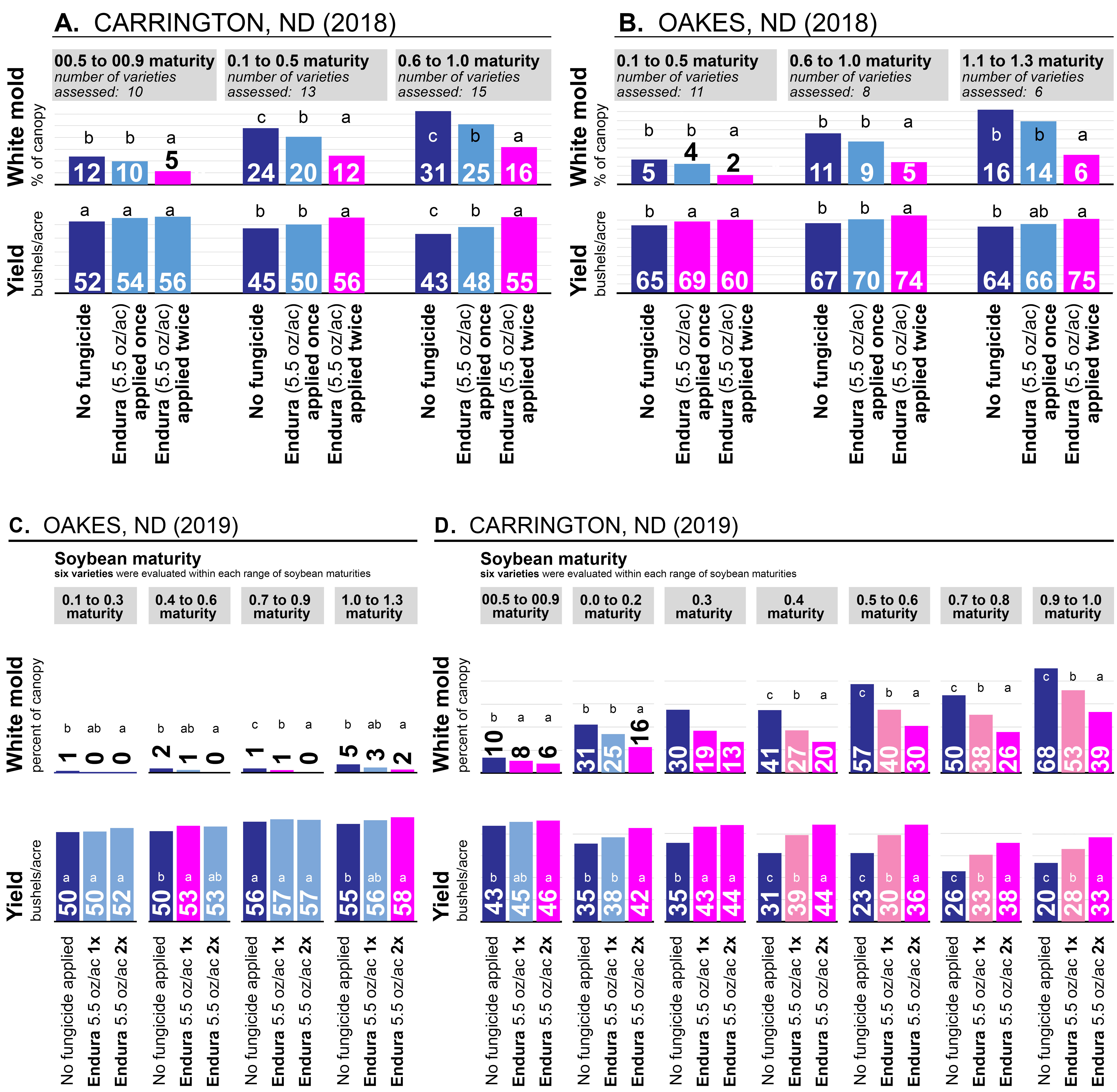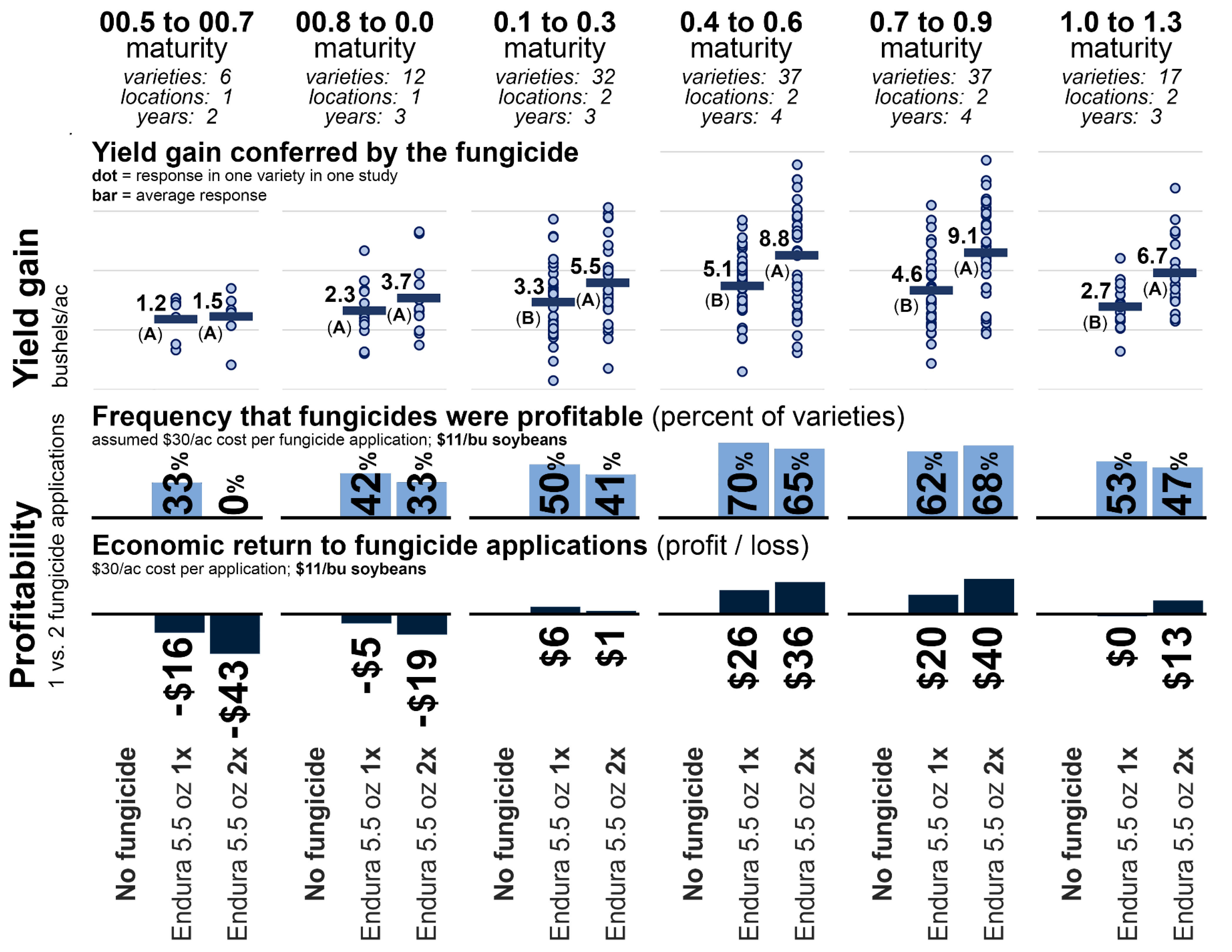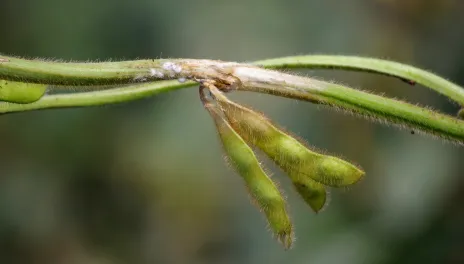Are two fungicide applications targeting white mold needed in soybeans or is a single application sufficient?
When conditions favoring white mold extend throughout the bloom period, it is common practice to make two fungicide applications targeting white mold to dry edible beans. In irrigated dry bean production, some producers even make three fungicide applications targeting white mold in dry beans.
A common question from growers, commercial agronomists and crop advisors is whether a single fungicide application targeting white mold is sufficient in soybeans when conditions favoring white mold extend through the bloom period, particularly in irrigated production.
METHODS: To address this question, the Carrington Research Extension Center conducted large studies in irrigated soybeans in 2018 and 2019 evaluating the response to one versus two fungicide applications targeting white mold. Research was conducted on fields with a history of white mold at the Carrington Research Extension Center and at the NDSU Robert Titus Research Farm in Oakes. In Carrington, 39 and 42 varieties of 00.5 to 0.9 maturity were evaluated in 2018 and 2019, respectively. In Oakes, 25 and 24 varieties of 0.1 to 1.3 maturity were evaluated in 2018 and 2019, respectively. Soybeans were seeded to rows 14 inches apart at 165,000 pure live seeds/ac. The Oakes site is irrigated sand, and irrigation was applied with an overhead linear irrigator as needed to maximize soybean agronomic potential. The Carrington site had loam soils, and overhead irrigation was applied with overhead micro-sprinklers as needed to simulate a wet year such that conditions were favorable for white mold throughout the bloom period. All varieties were assessed with 0, 1, or 2 applications of the fungicide Endura (5.5 oz/ac) applied at the early R2 growth stage (within 24 hours after 70% of plants had reached the R2 growth stage) or at R2 plus 10-12 days later. Fungicide droplet size was calibrated relative to canopy closure: Fungicide applications were made with TeeJet AIXR110015 flat-fan nozzles, with applications made at 60 psi (medium droplets) when average canopy closure in a variety was ≤ 90% and with applications made at 40 psi (coarse droplets) when average canopy closure in a variety was >90%.
RESULTS:
- Susceptibility to white mold increased with soybean maturity (Figure 1). While differences in susceptibility among soybean varieties were observed among soybean varieties of similar maturity length, on average, longer-maturity varieties were more susceptible to white mold than shorter maturity varieties. The increased susceptibility of soybeans to white mold as soybean maturity increases has been documented in other regions of the United States as well and is well established. As soybean maturity increases, the soybean bloom period becomes longer, which extends the period in which soybeans are susceptible to white mold infection.
- The yield gain conferred by a single fungicide application targeting white mold increased with soybean maturity (Figures 1, 2). When conditions favored white mold throughout the bloom period, the yield gain conferred by a single fungicide application targeting white mold averaged 1-2 bu/ac in 00.5 to 0.0-maturity soybeans and averaged 3 to 5 bu/ac in 0.1 to 1.3-maturity soybeans.
- In soybeans of 0.4 and longer maturity, making two fungicide applications targeting white mold was generally more profitable than making a single fungicide application (Figure 2). In soybeans of 0.4 to 1.3 maturity, the second fungicide application conferred an average 3.7 to 4.5 bu/ac yield increase versus a single fungicide application. When conditions favored white mold throughout the bloom period, a single fungicide application was insufficient for protecting the crop for the duration of the bloom period in soybean varieties of 0.4 and longer maturity: The bloom period in these varieties was longer than the residual protection offered by the first fungicide application.


CONCLUSIONS: In soybeans, just like in dry beans, a single fungicide application targeting white mold is insufficient when soybean maturity is 0.4 or longer and conditions favor white mold for the duration of the bloom period. A second application is also needed in soybeans of shorter maturity that are highly susceptible to the disease.
Poor white mold management is regularly reported in irrigated soybean production even when a fungicide application was made targeting white mold at early bloom. The results from this research suggest that the poor white mold management observed in such fields may be caused, at least in part, by the inability of a single fungicide application to extend satisfactory protection against white mold for the duration of the bloom period, particularly when soybean maturity is 0.4 or longer. When cool weather favorable for white mold (frequent daytime highs in the mid-80°F range and lower) occurs during bloom, irrigated soybean producers should consider making two fungicide applications targeting white mold in soybeans, just as is routinely conducted in dry beans. In dryland production, a second application is also likely to be needed in fields with a history of white mold when recurrent rainfall and cool weather extends throughout the bloom period.
Research leader: Michael Wunsch, plant pathologist, NDSU Carrington Research Extension Center. Contributing researchers: Thomas Miorini, Jesse Hafner, Suanne Kallis and Billy Kraft, NDSU Carrington Research Extension Center; Kelly Cooper, Heidi Eslinger and Seth Nelson, NDSU Robert Titus Research Farm, Oakes.
Michael Wunsch, Ph. D.
Michael.Wunsch@ndsu.edu
Plant Pathologist
